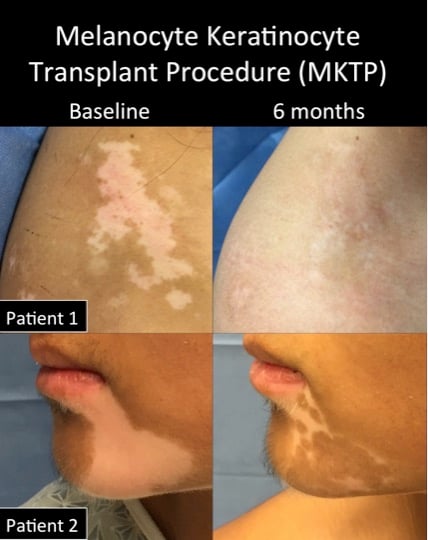Wednesday, December 30, 2015
|
 Many have heard that some forms of vitiligo can be treated with surgical approaches, like skin or cellular grafts. The idea is that the top skin layer of the white spots is removed, and healthy pigment cells (melanocytes) from another part of the body are transplanted there. After a few months, the transplanted melanocytes start working to make pigment, which deposits in the surrounding skin and the white spots disappear. This can be a very effective treatment for some patients, and many times the standard vitiligo treatments (read about them here) are no longer needed. The caveat is that it doesn’t work for every, or even most, patients.
Many have heard that some forms of vitiligo can be treated with surgical approaches, like skin or cellular grafts. The idea is that the top skin layer of the white spots is removed, and healthy pigment cells (melanocytes) from another part of the body are transplanted there. After a few months, the transplanted melanocytes start working to make pigment, which deposits in the surrounding skin and the white spots disappear. This can be a very effective treatment for some patients, and many times the standard vitiligo treatments (read about them here) are no longer needed. The caveat is that it doesn’t work for every, or even most, patients.
The problem is that the white spots appear in the first place because immune cells crawl into the skin, find the melanocytes (the pigment factories), and kill them (read more about that here). Then there is no more pigment production and the skin turns white. Typically, if you go through a procedure to transplant more melanocytes to that spot, the immune cells simply crawl in and kill the new ones too. However when the disease is stable, in that the immune system is quiet and no longer attacking the melanocytes, the newly transplanted melanocytes can survive and start working. The problem is that it is very difficult to know when the disease is stable, and dermatologists who perform this procedure usually require that patients have no new or expanding lesions for 1-2 years. But even then, the procedure is only effective 40-50% of the time, and it may fail later if the disease becomes active again, which is often unpredictable.
However patients with segmental vitiligo, where the disease is limited to only one side of the body, appear to be excellent candidates for this procedure. These patients have a good outcome 80-95% of the time, and they usually don’t require any more treatments. This may be one case when vitiligo may be cured, a word that we don’t use too often for patients with vitiligo (read why here). There are a number of ways to transplant healthy melanocytes in patients with stable vitiligo, including:
Punch grafts (small plugs of skin are transplanted to holes created in the white spots)
Split thickness skin grafts (larger pieces of skin are transplanted to white spots where the skin has been removed)
Blister grafts (blister roofs from normal skin are transplanted to white spots where other blister roofs were removed)
Cellular grafts (melanocytes and other skin cells from normal skin are transplanted to white spots where the top layer has been removed by dermabrasion or laser treatment)
Each procedure has pros and cons, but it seems that the cellular grafts have the best results and can cover the largest areas; this is typically called the Melanocyte-Keratinocyte Transplant Procedure, or MKTP. However MKTP requires special training and equipment. In fact, only a few centers around the world offer this treatment, including 3 centers I am aware of in the US: The Vitiligo Clinic and Research Center (our center) in Worcester, MA; the Dermatology Dept. at Henry Ford Hospital in Detroit, MI; and the Dermatology Dept. at UT Southwestern in Dallas, TX. Dr. Iltefat Hamzavi at Henry Ford Hospital has been performing the procedure the longest, and taught the rest of us in the US how to do it. He learned from Dr. Sanjeev Mulekar from New Delhi and Mumbai, India, who also travels to perform the procedure in Riyadh, Saudi Arabia and London, England.
We have seen excellent results with MKTP in our center (performed by Dr. Dori Goldberg, a procedural dermatologist at UMass and member of the Vitiligo Clinic and Research Center) and at the other locations mentioned above. Examples of two of our patients are presented above, pictured before and 6 months after the procedure, and they will continue to improve for another 1-2 years. The procedure takes 2-4 hours (depending on the size of the area to be treated) under local anesthesia (the skin is numbed with injections), and bandages remain in place for 1 week. We think it is a great option for the right patients, however many dermatologists are not aware that MKTP exists, it can be expensive (typically $2000-$4000 in the US), and it is not currently covered by most insurance. We hope that more locations will begin to offer MKTP for their patients so that more people can experience its benefits!